Strasbourg have been going from strength to strength since ending a nine-year absence from France’s top-flight when they earned promotion to Ligue 1 back in 2017. In their first season back among France’s elite, the 2017/18 campaign, Strasbourg earned a 15th placed finish in Ligue 1.
Last season, Le Racing improved on that position by finishing in 11th place on the table, which is the same position that they currently occupy on this season’s table, however, in a tight Ligue 1 campaign, Strasbourg currently sit just three points away from fifth place, whilst having played a game less than all other teams in the league, bar PSG.
With that in mind, it may be fair to say that Strasbourg could still end up looking back at the 2019/20 campaign as another one in which they achieved progression.
Strasbourg’s tactics have played a key role in helping them to get into the position that they currently occupy, which is one that may give them a decent chance to ensure that the 2019/20 season ends successfully once Ligue 1 resumes and they can complete their remaining games.
They are a side who have ranked positively in a variety of statistics when measured against their fellow Ligue 1 sides, based on the 2019/20 campaign. Strasbourg’s positive performance in some statistics tells us a lot about their style of play and tactics.
In this tactical analysis piece in the form of a scout report, we will attempt to identify and explain some of the key aspects of Strasbourg’s tactics throughout the 2019/20 campaign. We will discuss some of the main positives and negatives of the tactics that have been deployed by Thierry Laurey’s team in this tactical analysis piece.
Strasbourg’s defensive tactics and style of pressing
When watching Strasbourg play, their defensive style of play and tactics become quite clear. Firstly, as per Wyscout, nine of Strasbourg’s 32 Ligue 1 goals this season have come from a counterattack. This equals 28% of their goals coming from this type of situation. Only PSG have scored a higher number of goals from counterattacks than Le Racing have in Ligue 1 this term.
Strasbourg’s pace, organisation, and effective direct play are all key aspects of their success on the counter this season which we will discuss in this tactical analysis piece, however, it may be fair to say that Strasbourg’s counterattacking success begins with the successful implementation of their defensive tactics.
Strasbourg’s well-organised press is a key element to their counterattacking success. Only three Ligue 1 sides have got a lower PPDA than them at present this term. Wyscout defines ‘PPDA’ as ‘opponent passes per defensive action in the opponent’s final 60% of the pitch’. As a result, we can use this statistic to help us determine that Strasbourg press relatively intensely and tend to allow their opponents a relatively low amount of time on the ball within their first 60% of the pitch, when compared with their fellow Ligue 1 competitors.
While their press ranks as one of Ligue 1’s most intense, Wyscout also ranks Strasbourg as having made the fourth-lowest number of ball recoveries in their final third of the pitch in Ligue 1 this term. That knowledge, combined with our knowledge of Strasbourg’s PPDA statistics, can help us to determine that while Strasbourg press with intensity in their first 60% of the pitch, they attempt a relatively low number of defensive actions within the final third, heavily focusing their attempts at recovering the ball to within the first two-thirds of the pitch nearest to their own goal.
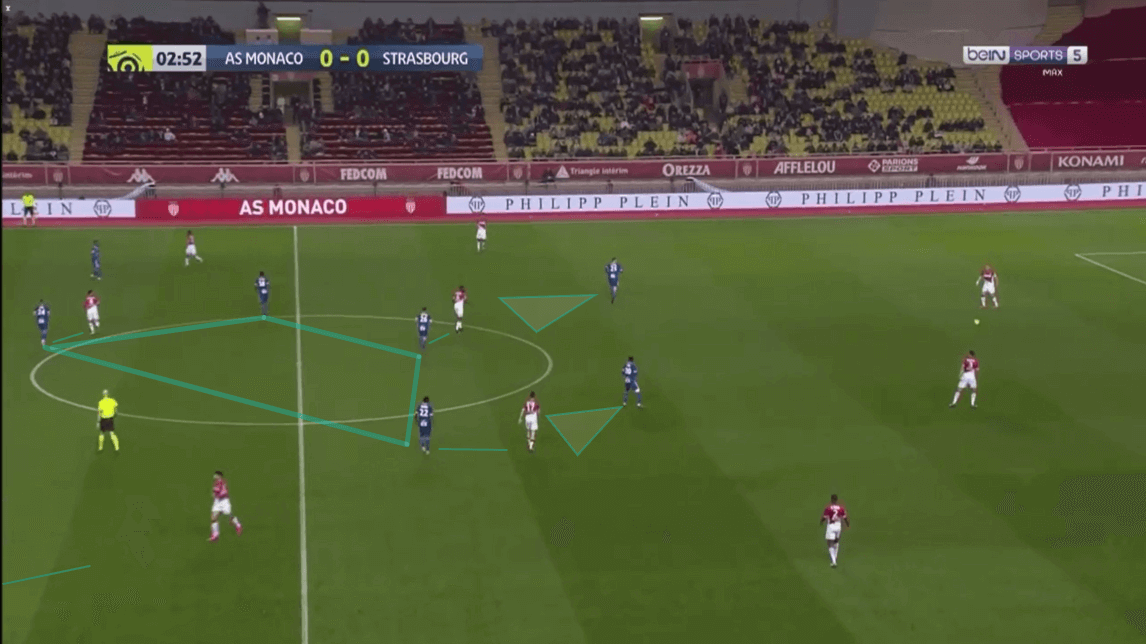
This image above, which is taken from Strasbourg’s clash with AS Monaco from 25 January provides us with an in-game example of Strasbourg’s defensive tactics, including their methods of pressing.
Firstly, as they can be seen doing in this image, Le Racing have utilised a 4-diamond-2 shape more often than any other in Ligue 1 this term. This shape helps them to maintain a central overload and essentially control the middle of the park, as their four narrow midfielders generally stand within close proximity to one another, often making it difficult for the opposition to play through the lines.
As this image shows us, while Monaco’s centre-backs are in possession of the ball, Strasbourg’s two centre forwards basically make little to no active effort to dispossess them. Instead, Strasbourg’s two strikers drop deeper, placing themselves close to Monaco’s pair of central midfielders, cutting off the passing lanes to those two players via their positioning which keeps both midfielders in their respective cover shadows.
Two of Strasbourg’s central midfielders also step up to mark Monaco’s midfield duo during this passage of play. As Monaco’s right centre-back receives the ball, Strasbourg’s left striker pushes out wide to cover the pass to the right-back, which forces the centre-back to play the ball across his backline once more. Strasbourg’s defensive shape essentially leaves Monaco with no choice but to play through their left-back here upon switching the play or taking a risk and playing the ball long.
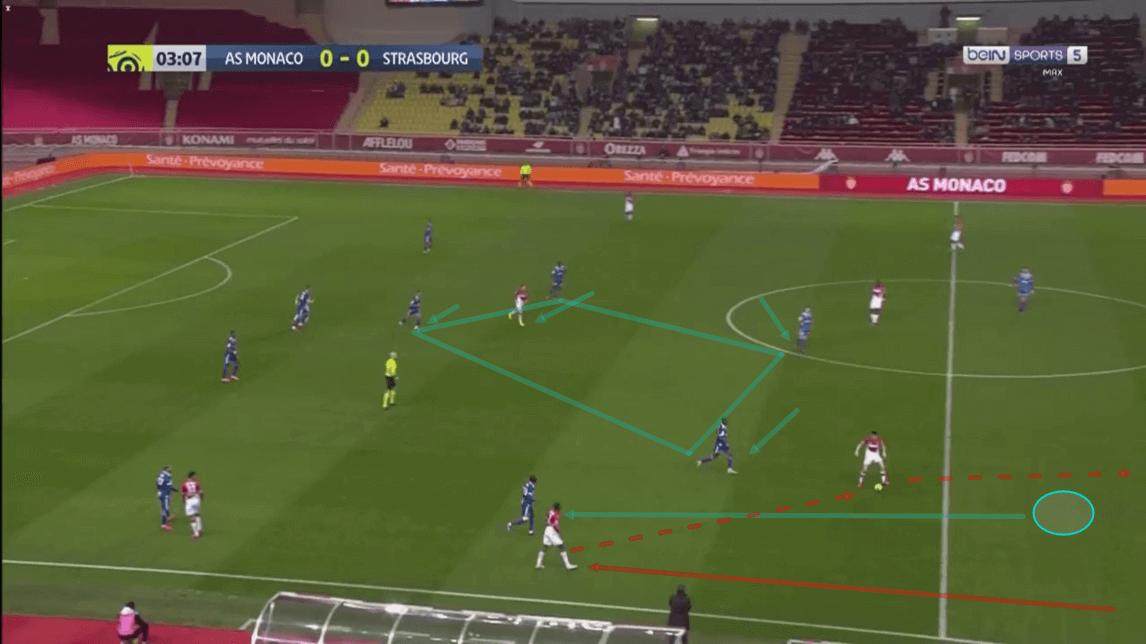
As this next image shows, as this particular passage of play continues, the ball does ultimately get played out to the left side of the pitch by Monaco as they attempt to play out from the back.
Left-back Fodé Ballo-Touré does receive possession for Les Monégasques, however, as we can see, the focus of Strasbourg’s defensive black has shifted over to this side of the pitch, while their press has also become more intense as Monaco have advanced into Strasbourg’s half.
As a result, Monaco were ultimately unable to build out from the back past Strasbourg’s press here, being forced back the pitch due to Strasbourg’s effective pressure.
This passage of play provides us with a good example of Strasbourg’s pressing tactics. As Monaco played the ball from the right side of the pitch over to the left-wing, Strasbourg’s defensive shape, shifted out to that wing. Le Racing’s right central midfielder pushes out from the central diamond shape that he had been a part of in the middle of the park in order to press Monaco’s left-back, while their right striker also drops deep, now essentially joining the midfield diamond in the other midfielder’s place.
While the right central midfielder broke away from his position, the well-organised nature of Strasbourg’s pressing tactics meant that this worked out well and ended up playing an important part in Le Racing effectively forcing the opposition backwards.
This passage of play also provides us with an example of another principle of Strasbourg’s defensive tactics, which is their emphasis on central overloads when playing without the ball. As we saw here, Strasbourg essentially made sure that they had four men occupying the central positions as a part of their diamond formation at all times during Monaco’s build-up play.
In the first image, we can see a pure example of how Strasbourg’s 4-diamond-2 formation lines up, while the second image shows us that despite Le Racing’s right central midfielder pushing out to the wing, thus vacating his central position, Strasbourg maintain their central diamond shape as their right striker temporarily drops into that role. This control over the centre of the pitch helps Strasbourg to force the opposition out wide, which then triggers their press, as this example has shown us.
Another important element of Strasbourg’s defensive tactics which we must discuss, is their style of marking. In the first image above, we can see Strasbourg’s holding midfielder, Alexander Djiku, marking Monaco playmaker Cesc Fàbregas. Djiku essentially man-marks the former Arsenal, Barcelona, and Chelsea midfielder during this passage of play, following him over towards the left side of the pitch, despite this resulting in Strasbourg’s midfield shape being slightly altered.
However, as play moves on and the ball progresses to the opposite wing, Djiku ‘passes on’ the player that he had been marking to Le Racing’s left central midfielder, who then takes on the man-marking job.
This provides us with an example of Strasbourg’s ‘flexible man-marking’ defensive approach. When they pick up a player, Strasbourg’s men mark them quite tightly. However, they operate with a certain element of freedom with regard to this marking, as they can pass players onto their teammates, who will then pick up where the other player left off. This style of marking has been a common theme to Strasbourg’s defensive tactics this season.
Strasbourg defensive weaknesses
While Strasbourg have primarily played with a 4-diamond-2 shape this season, they have utilised different formations at times. However, the principles of their defensive tactics generally don’t alter much, despite any change in formation.
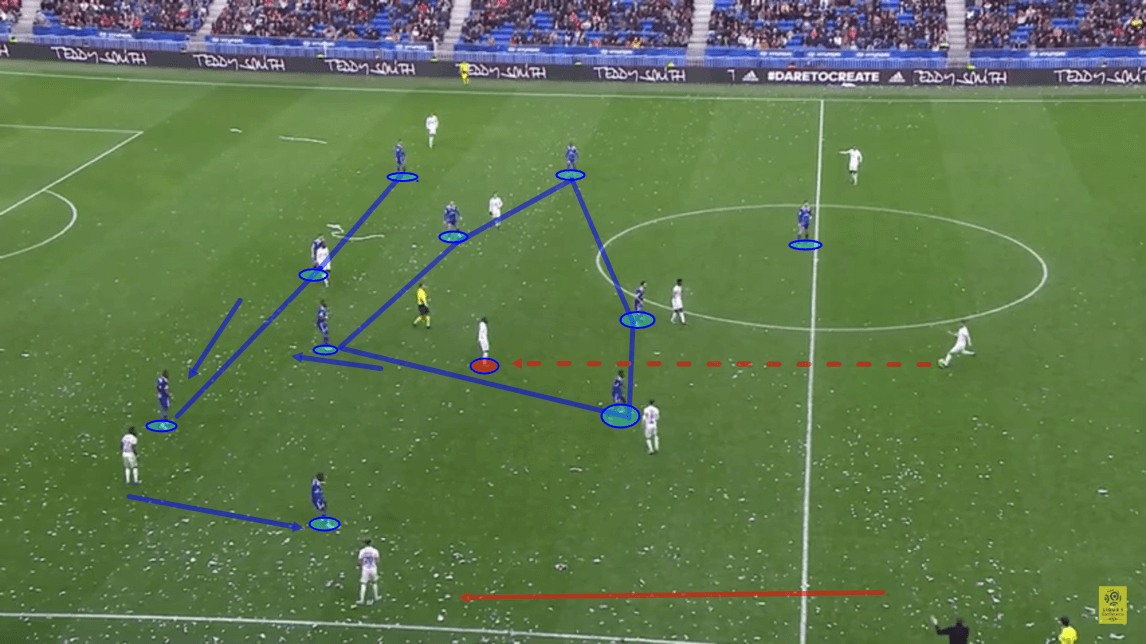
More recently, Le Racing have been seen utilising a 4-2-3-1 shape in some Ligue 1 fixtures. However, despite that, their styles of both pressing and marking, in addition to their emphasis on maintaining control of the centre of the pitch all remain constant in this shape, similar to how they exist within the 4-diamond-2 shape which we saw them utilising in the previous section. The image above shows us an example of Strasbourg defending in a 4-2-3-1 shape in a recent Ligue 1 clash with Olympique Lyon.
Firstly, this image shows us how Strasbourg attempt to maintain control of the middle of the park off the ball when utilising a 4-2-3-1 formation. As Lyon attempt to play out from the back here, Strasbourg’s double-pivot drops deep, getting very vertically compact with the defensive line. Meanwhile, as Strasbourg’s number ‘10’ marks one central opposition player tightly, their two wide men come quite narrow, essentially helping their side to create something of a pentagon shape in the midfield.
However, while this central overload is evident, Lyon still manage to play through the centre of the pitch on this occasion. This occurs as Les Gones successfully manipulate Strasbourg’s midfield shape, taking advantage of their commitment to their man-marking style defending in order to create some space for one Lyon player to become free in the midfield.
As Lyon attempt to build out from the back, their two full-backs advance far up the pitch. As their left-back positioned himself high on the left-wing, this prompted Strasbourg’s right-back to push out of the defensive line to pick him up. However, in doing so, the right-back then forces his right central defensive teammate to shift over, firstly, in order to try and maintain a decent distance between the two defenders, but also in order to pick up Lyon’s left-winger who shifted inside as the left-back pushed up.
This centre-back’s movement creates a gap between the two centre-backs which Strasbourg’s right holding midfielder attempts to plug by dropping even deeper. However, this then allows one Lyon midfielder to enjoy some freedom in the centre of the pitch, as we can see in the image above.
Strasbourg’s right-winger and number ‘10’ are both already occupied with other Lyon players, while the right holding midfielder has now joined the defensive line. As a result, Lyon successfully manage to play through the lines and open up Strasbourg through the middle of the pitch, due to Le Racing’s style of marking being successfully manipulated by an intelligently put together Lyon attack.
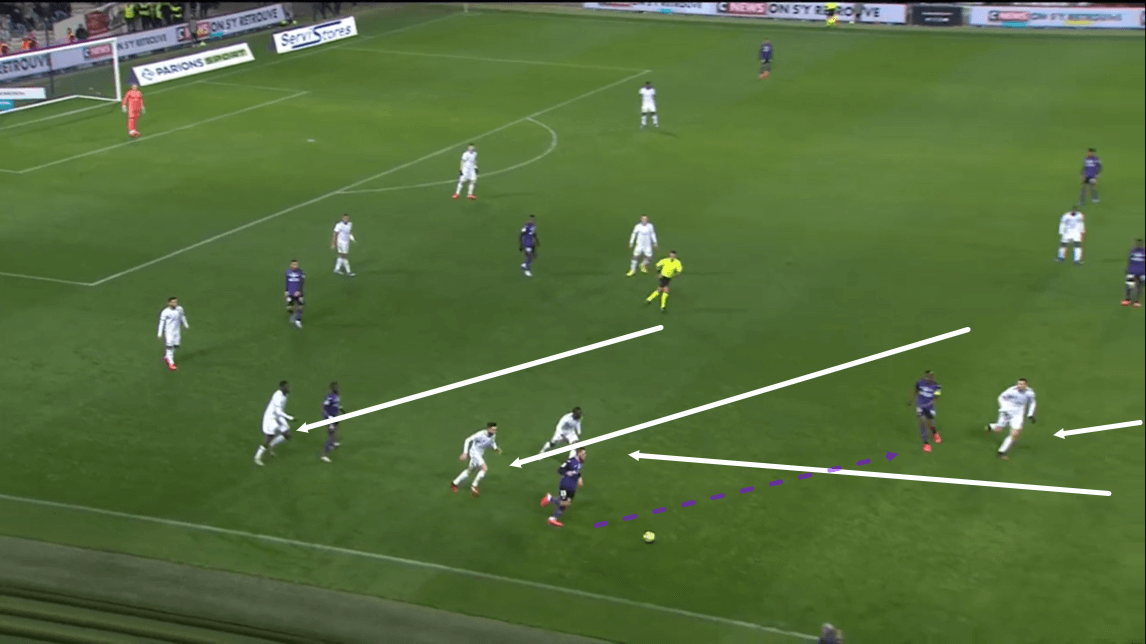
This next image shows us another example of Strasbourg’s defensive shape being manipulated by the opposition. As a result of Strasbourg’s tendency to focus on maintaining control over the centre of the pitch, they can sometimes be exposed in the wider areas of the park.
Just prior to the image above being taken, Strasbourg’s opponents here, Toulouse, built an attack on the left-wing. As they progressed down the left-wing, two Strasbourg midfielders, their right-sided central midfielder and their number ‘10’, were drawn away from the centre of the pitch in an attempt to press the opposition attackers. Meanwhile, both of Strasbourg’s two centre forwards also push out to support this press on the ball-carriers.
However, as play moves on, Toulouse manage to work the ball around this press in the wide area and play it into the centre of the pitch which is now an area that they can exploit.
As play moves on, Toulouse successfully build a dangerous attack through the middle of the park. Strasbourg’s central players were caught out of position as they failed to recover possession on this occasion from their press.
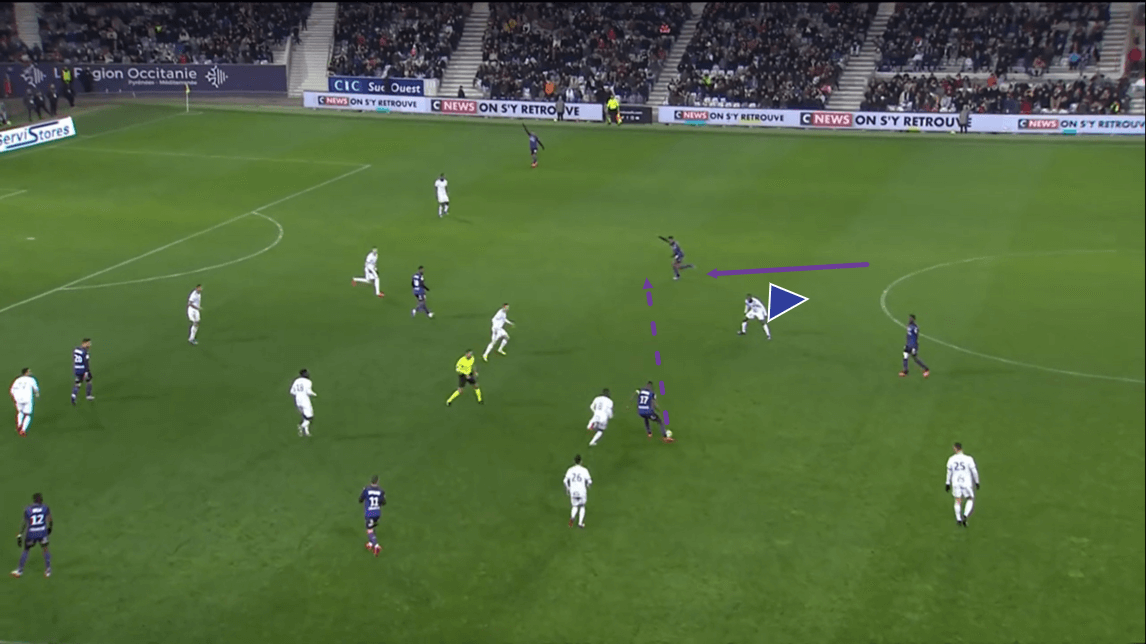
In the image above, we can see that this run from one Toulouse player, who had been sitting deeper, manages to catch out Strasbourg’s defensive players. The Strasbourg man who had been marking this player who would go on to receive the ball had originally been keeping him in his cover shadow. However, as Toulouse advanced into the centre of the pitch, this player loses his marker and gets played through, being presented with a shooting opportunity as a result.
While there have been plenty of positive things to say about Strasbourg’s defensive tactics this season, these two passages of play from this section have shown us that it is also possible to manipulate Le Racing’s defensive shape and cause them problems in doing so.
Strasbourg’s use of width in the attack
One of the key elements to Strasbourg’s offensive tactics this season has been their use of width in their attacking moves. Le Racing often maintain their central overload in the build-up phase of play, similarly to how they do so during the defensive phase. However, as they progress the ball into the final third of the pitch, they generally tend to make greater use of the wings in creating the final phases of their attacks.
This frequent use of the wings during the latter stages of their attacks has led to Strasbourg making an average of 15.54 crosses per game this season in Ligue 1, as per Wyscout, which is the third-highest number of crosses that have been played, on average, by any side in France’s top tier this term, trailing only PSG and Montpellier in that regard.
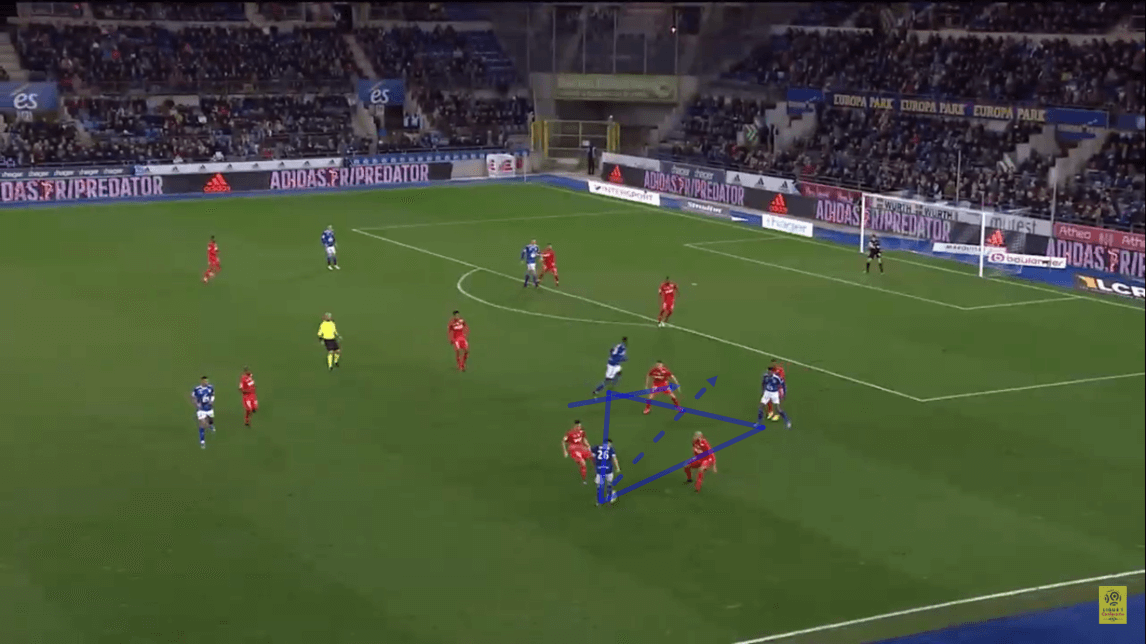
This image above shows us an example of a scenario which frequently presents itself during the latter stages of a Strasbourg attack. As we can see here, Le Racing have created a triangle high on the right-wing. In addition to attacking from the wide areas frequently, Strasbourg often build a greater number of attacks down the right side of the pitch than they do on the left.
On this occasion, Strasbourg’s number ‘10’, who we can see playing the ball here, links up with their right striker and one of their midfielders to create this wide triangle. However, while the strikers will come out wide to help advance the ball during this phase of play if needs be, in general, Strasbourg’s two centre forwards tend to remain central, particularly Ludovic Ajorque, the club’s joint-highest league goalscorer this season, whose aerial ability is a big asset for Le Racing in the penalty area.
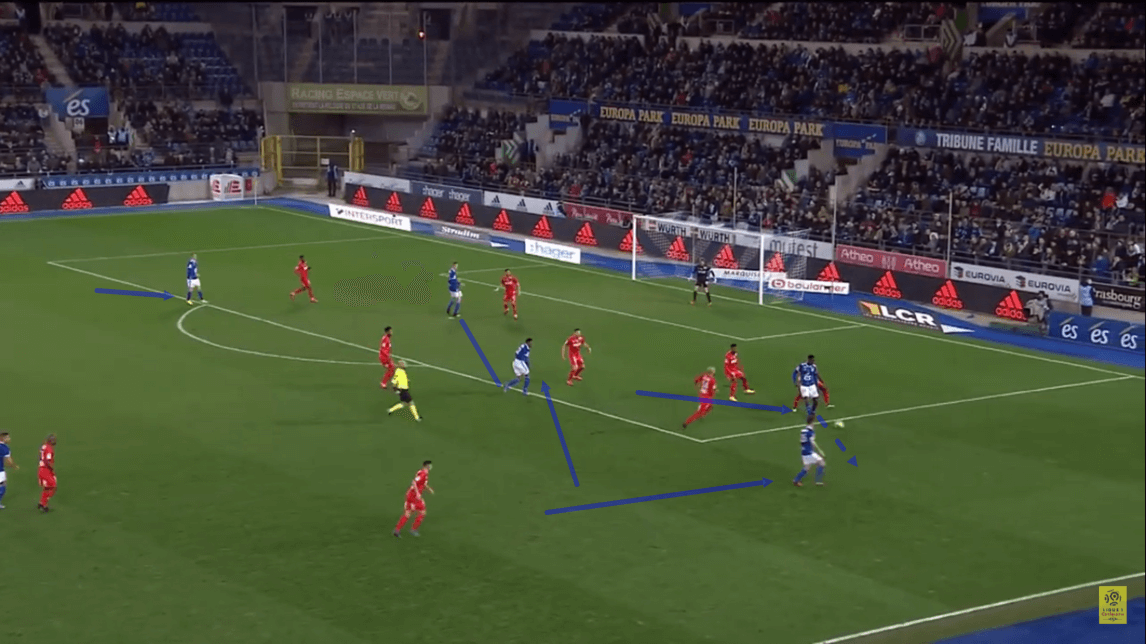
As this passage of play moves on, right striker Lebo Mothiba runs centrally to join his strike partner Ajorque in the box. Meanwhile, the playmaker who played the pass in the previous image ends up shifting out wide, while the midfielder who previously received possession brings the ball out to play it back to the number ‘10’ who is now relatively free on the right-wing.
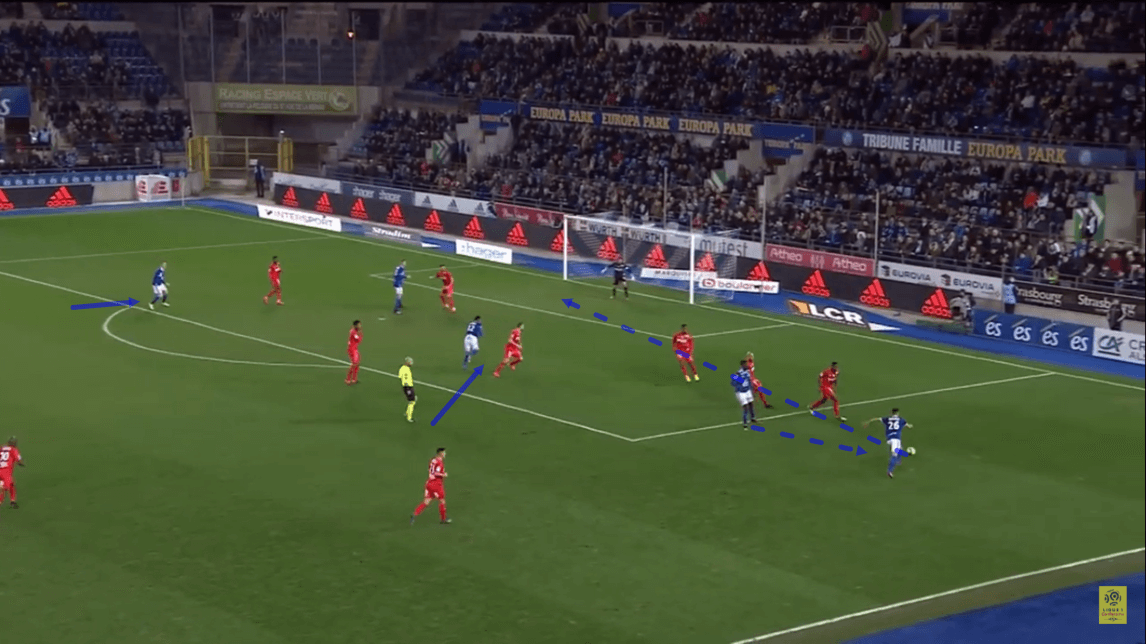
Thanks to the effectiveness of Strasbourg’s triangle on the right-wing, the number ‘10’ enjoys an opportunity to drive a cross into the box which Le Racing are ultimately unlucky not to capitalise on. However, while Strasbourg didn’t score from this particular passage of play, it may be fair to say that this offensive move provides us with a clear example of Strasbourg’s effectiveness in the wide areas when operating within the final third of the pitch.
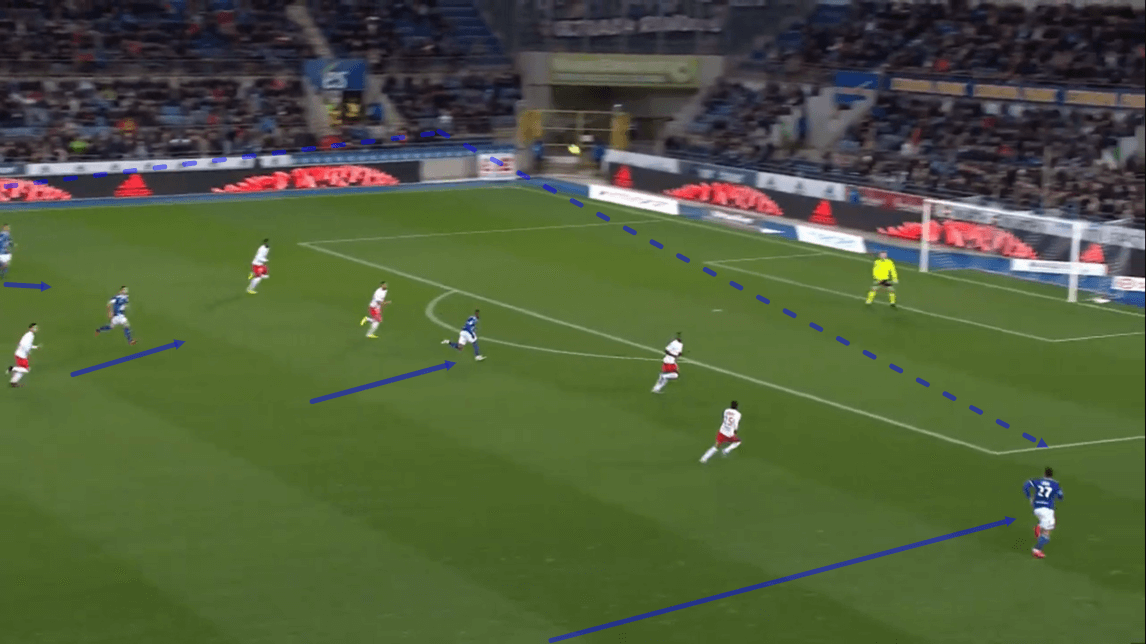
Full-back Kenny Lala plays an important role in Strasbourg’s offensive tactics. His pace is, at times, vital for Strasbourg on the counter, while his movement along the right-wing is often a useful asset as Strasbourg attempt to create via the wings. This image above shows us an example of one of the ways in which Lala is often used to great effect by Strasbourg during the offensive phase of play.
On average, Lala has made 3.7 progressive runs per game this season in Ligue 1, according to Wyscout, who rank the Strasbourg full-back as having made the sixth-highest number of progressive runs in France’s top tier this season. Meanwhile, Lala has also made an average of 3.74 crosses per game in Ligue 1 this term, as per Wyscout, with only nine players making more crosses per game than the Strasbourg full-back this season.
Just prior to this image being taken, Strasbourg were in possession of the ball in the left-back position, however, Lala made a positive run on the right-wing which was spotted by his teammate who played a long, cross-field ball to pick out the full-back. Le Racing have played this type of cross-field ball to pick out a progressive run from Lala on multiple occasions this season.
As this particular passage of play moves on, Lala sends a cross into the box first-time which creates a dangerous goalscoring opportunity for Le Racing. This play may provide us with another example of Strasbourg’s effectiveness at creating via the wings.
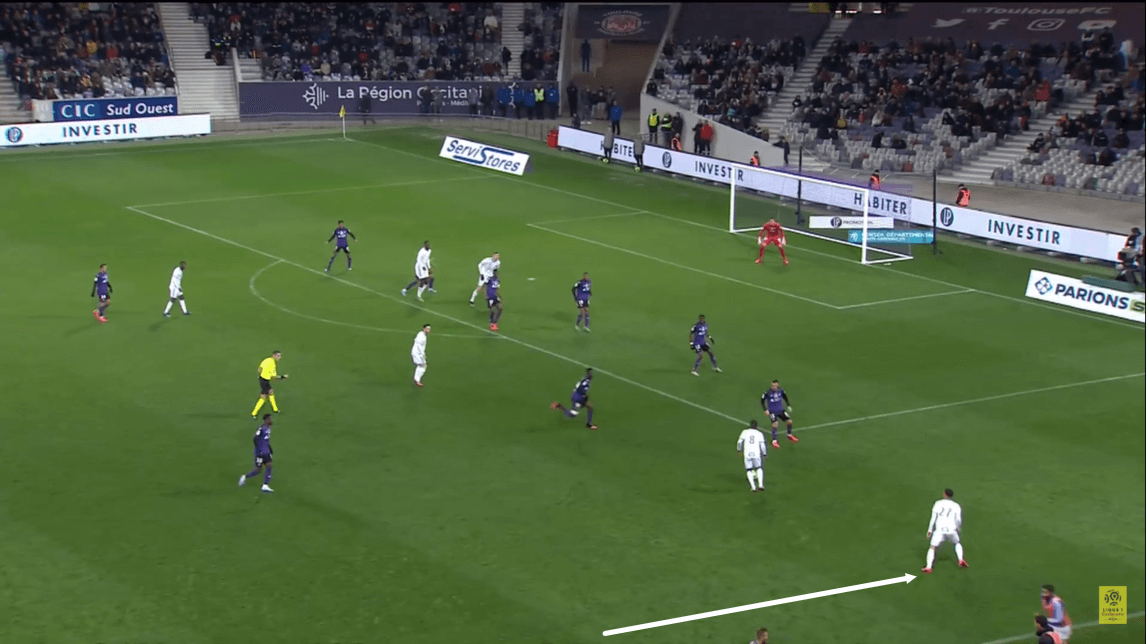
Furthermore, in addition to making runs to get onto the end of cross-field balls, Lala can often be seen making himself an option for more simple passes during the offensive phase, via overlapping runs around his teammate who is occupying the wing at the time. We can see an example of Lala making one of these types of runs in the image above.
Here, the opposition are defending in quite a narrow and compact fashion. This allows Lala to push into a position in which he could potentially enjoy plenty of space if the ball were played through to him. On this occasion, Lala’s teammate ignores his run, opting to attempt a cross of his own, however, this provides us with a clear example of Lala’s attacking intent and the kinds of dangerous runs that he can often be seen making on the wing.
Strasbourg’s effectiveness on the counterattack
As we previously touched upon, Strasbourg have been one of Ligue 1’s most effective sides on the counterattack this season. In addition to having scored 28% of their goals from a counterattacking situation, as per Wyscout, Strasbourg have made the third-highest number of progressive passes in Ligue 1, per game this season. Additionally, Strasbourg have also made passes at an average length of 21.45m, which gives Le Racing the longest average pass length in Ligue 1 this term.
It may be fair to say that Strasbourg’s success on the counterattack, in addition to their high number of progressive passes and their relatively long average pass length all point to them being quite comfortable with utilising a relatively direct style of play. This may be due, in part, to Strasbourg’s effectiveness at turning defence into attack quickly, thus capitalising on the opposition’s weakened defensive state during the transition phase.
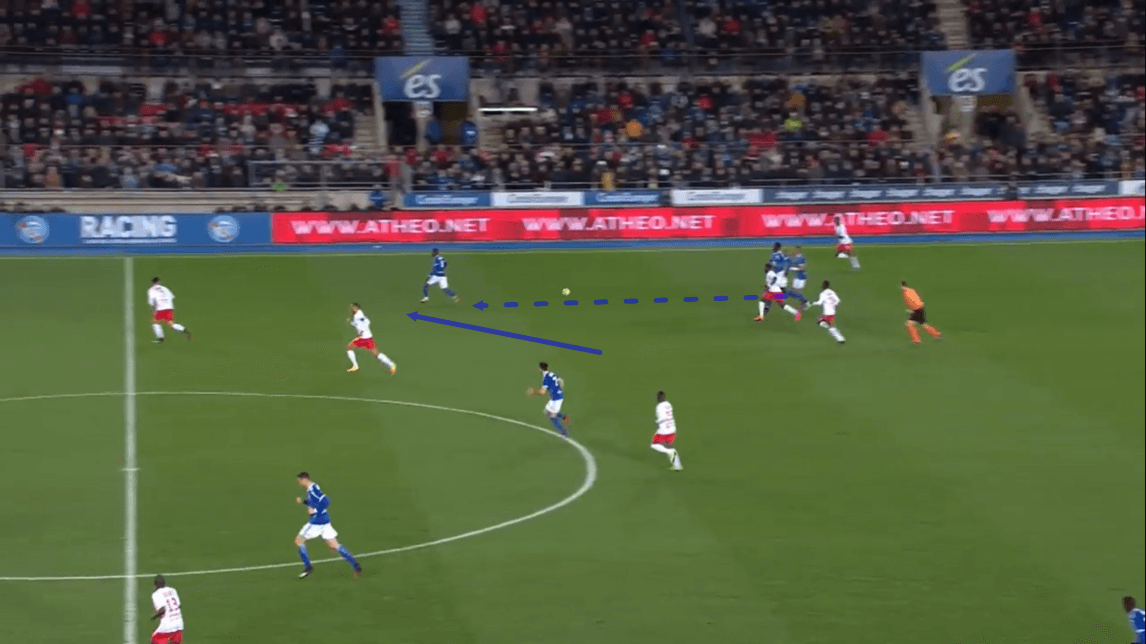
This image above provides us with an example of a Strasbourg counterattack in its early stages. Just prior to this image being taken, Le Racing managed to win back possession of the ball inside their own half. As they transition to attack, one man heads straight for the right-wing in an attempt to help his side exploit the width on the counter. Strasbourg quickly find this player and many of his teammates quickly rush up the pitch in support.
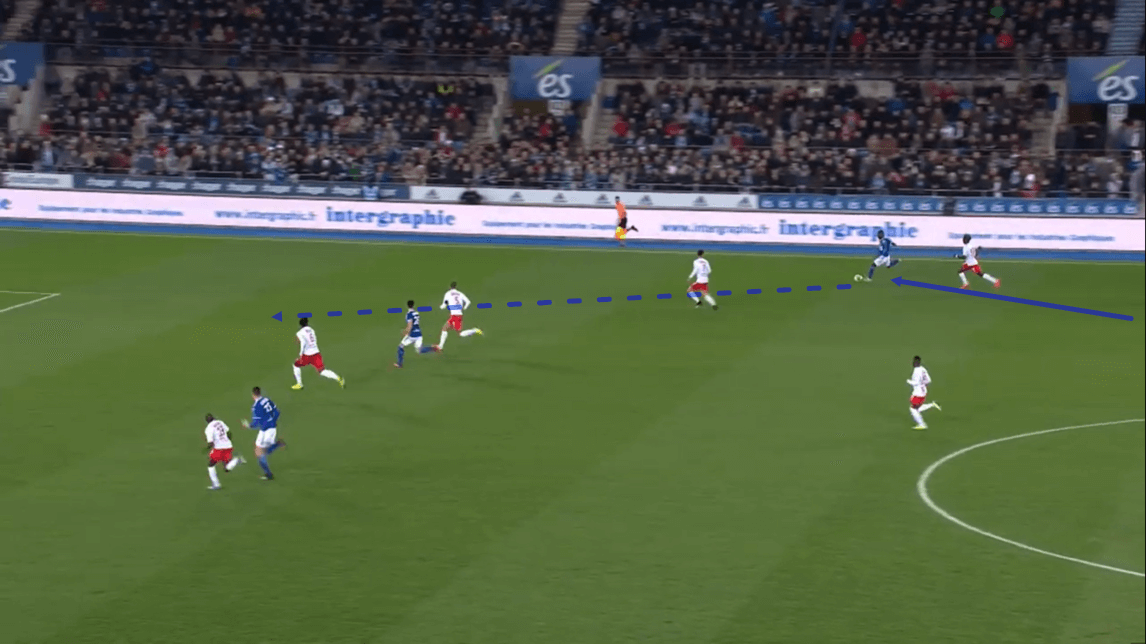
As this counterattack plays out, the wide man manages to advance up the wing, quickly getting into a crossing position. He subsequently plays the ball across goal, creating a dangerous goalscoring opportunity for his side which ultimately ends up forcing the opposition defenders to make a goalline clearance in order to avoid conceding a goal.
While this specific counterattack ultimately didn’t result in a goal, it may be fair to say that this passage of play has provided us with a clear example of Strasbourg’s effectiveness at quickly turning defence into attack and quickly putting the opposition’s goal in danger from this type of scenario.
Conclusion
To conclude this tactical analysis piece in the form of a scout report, it may be fair to say that Strasbourg have shown themselves capable of hanging with top Ligue 1 opposition this term, producing some impressive football both during the defensive and offensive phase of play, in the process.
Strasbourg’s defensive tactics can be summarised by their emphasis on maintaining an overload in the centre of the pitch, a flexible man-marking system, and an intense press which is usually triggered outside of the final third and often when the ball is played out into the wide areas by the opposition.
Meanwhile, in attack, Strasbourg generally tend to build up through the centre before moving out into the wings as they advance into the final third. Furthermore, their quickness and effectiveness on the wings are also key in helping them to become one of Ligue 1’s most effective sides on the counterattack this season.





Comments